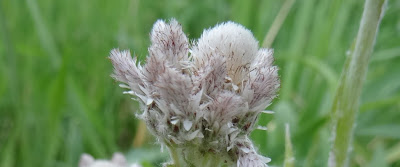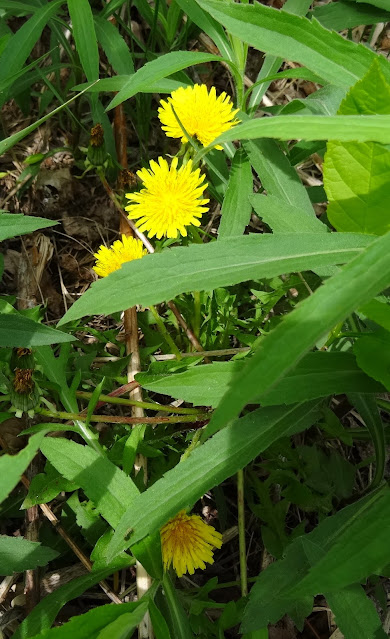6/01/2022
pussytoes 6-1
5/21/2022
early purple ivy blooms
creeping charlie, gill-over-the-ground, alehoof,
tunhoof, catsfoot, field balm, or run-away-robin.
I admire the shape and texture of the leaves, and
used them in a botanical design project.
5/20/2022
nest box peek
Tree Swallows lay eggs and
disguise them by sticking feathers
barb-down so the fluffy vanes curl over the contents of the nest.
5/18/2022
5/12/2022
nectar and pollen
sora, master of disguise
My new favorite bird! I just discovered the Sora Porzana carolina (a very secretive wetland bird) this Spring. I watch a pair every day, hunting at the edge of the pond. They think the mottled-pattern camouflage feathers makes them hard to spot. But the bright yellow bill gives them away. (see post on 4/24/2022)
5/11/2022
strutting blackbird
The blackbird was foraging among the short grasses near the pond. A female, recently arrived after migrating, landed on a branch of swamp willow. The male saw her and started displaying his handsome epaulets. He walked toward her with his feathers fluffed out and tail partly spread. As he proceeded, he lifted the leading edge of each wing so that the red shoulder patches were puffed up, appearing bigger. She flew to another small tree; he followed among the willow sprouts, displaying his male beauty to impress her.
(Red-winged Blackbird males have colorful upperwing coverts of red bordered with yellow on the bend of each wing. He will use the colorful display to threaten other birds, defend his territory, or attract a mate.)
5/08/2022
muskrat claws
Often we can see a muskrat swimming back and forth in the pond, harvesting plants and taking food home to the family. Muskrats Ondatra zibethica eat the roots, stems, leaves, and fruits of many water plants such as cattail, rushes, smartweed, duck potato, horsetail, sedges, and willow sprouts. They are strong swimmers due to their two long back feet and five webbed toes. For grasping and harvesting food, they have developed smaller front feet with four fingers with claws and a small thumb. By living near the pond, muskrats control plant growth, provide open spaces for new plants to grow, and make space for other animals to build their nests.
5/04/2022
5/02/2022
blue-winged teal
4/26/2022
green sprouting
After a late, cold and windy Spring season, there is finally some green leaves sprouting in the wetland surrounding the pond. These are the beginning leaves of Golden Alexanders.
4/24/2022
Sora
This very secretive bird, that usually hides among vegetation, today revealed itself at the edge of the pond! I hope this one will find a spot to nest among the dense vegetation of rushes and sedges.
Not often seen in the open, the Sora is a small chubby bird of freshwater shallow areas with plants such as cattails, sedges and rushes. Sora Porzana carolina is brown and gray with a mottled patterned body, 8-10" long. Despite their camouflage feathers, the bright yellow bill gives them away. It is stubby, thick, glowing yellow in a gray face with black mask.
Soras feed by pecking at the water surface for seeds, aquatic insects, or invertebrates. Long toes help them to rake through submerged vegetation for food items, and help them walk on floating mats of plants. They nest among dense plants at the pond edge.
4/19/2022
crow on rocks
This crow was trying to fetch seeds from the water surface by standing on two rocks.
4/15/2022
dabblers and divers
The pond area is bustling with birds arriving! Several species of ducks have stopped for a meal or a day of rest on migration. I marvel at how they tolerate one another in this small spot of respite. Occasionally we hear honking or see disputes, but mostly the creatures get along.
Animals have adapted their method to feed in different ways. For instance, we saw Mallards feeding near Hooded Mergansers. Mallards and Blue-winged Teal are ‘dabblers' – they dip their beak and head into the water to munch on shallow-water plants. Mergansers are ‘divers' – they dive totally under the water to eat plants growing in deep water.
4/14/2022
ducks on log
Hooded Mergansers Lophodytes cucullatus appear prominently on the pond when the weather is nice (you can not miss their dazzling appearance and active diving), and they disappear from view when it is not nice. This year, April has been colder than normal, rainy, and with mostly gray skies.
Waterfowl like these are here on their nesting ground. They can find shelter from bad weather in the weeds and reeds around the pond. This Hooded Merganser pair can find plenty to eat here . . . small frogs, tadpoles, insects, seeds, and even the roots or bulbs of water plants. When they're satisfied, the pond offers several exposed rocks, logs, and shallow bars for critters to use as loafing sites.
Next up -- finding a nesting site.
4/08/2022
silly gooses
4/04/2022
muskrat whiskers

3/31/2022
eagle nest, March
3/25/2022
robin likes suet
This bird has been coming to the suet feeder near the pond for several days. American Robins usually eat insects, invertebrates, and berries. This suet has seeds in it. They must be tasty to the Robin.
3/21/2022
'homing' Mallards
Mallards can stay through winter in Minnesota if they can find food near open water. Now that the solid shore-to-shore ice on the pond is melting, a pair showed up here. This is probably the same pair that nested near the pond last year, since Mallards are known to 'home' where they have nested previously.
Even though a fractured layer of ice floats nearby, these ducks find food beneath the water. This might be what is known as a 'cold lunch'.
3/11/2022
3/05/2022
icicles
March this year promises to be, as usual, a roller-coaster of weather.
Rain turned to sleet overnight as the temperature dropped.
This morning everything outside was coated with icicles, including bird feeders near the pond.
2/26/2022
hare
The pond has been
under a comforter of white snow. The snow layer insulates and protects the
critters tucked in among the rocks, mud, and dormant plants below water and
ice.
On a sunny day, we saw a large rabbit sitting in the snow near the pond. It created a depression in the snow among reeds and wildflower stems, and snuggled down there all day. At dusk, it was gone from that spot. The next day the sunshine was bright on the white snow. The rabbit was in the same spot again, and napped all day. I suspect it was a White-tailed Jackrabbit Lepus townsendii, actually a hare. Jackrabbits are nocturnal hunters and are known to take daylight naps in a shallow hole.
1/30/2022
eagle nest, January
The eagle nest near the pond is again claimed as home for a pair of Bald Eagles Haliaeetus leucocephalus. One was in the nest for a while before this, probably rearranging sticks to her liking in preparation to lay eggs.





























